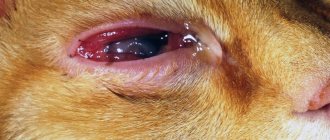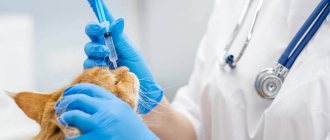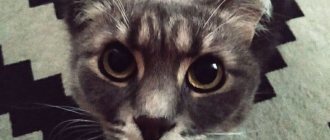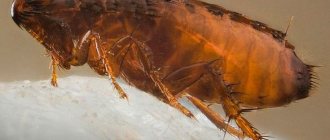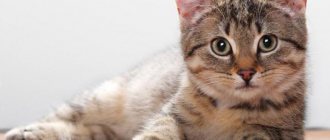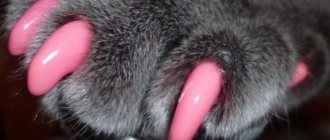For eye diseases in pets, experts most often prescribe drop therapy. Only a veterinarian at an appointment can competently explain how to put drops into a cat’s eyes. Knowing the features of instillation, you can perform the procedure yourself at home.
Typically, the doctor prescribes such procedures for several days, and instillation will need to be done two or three times during the day. Properly performed manipulation should not become an unpleasant procedure for the cat.
IMPORTANT! If 2 medications are prescribed, instillation should be carried out at intervals of 10-15 minutes. Means used simultaneously will not give a positive result.
Preparing the owner and cat for a medical procedure
Before the procedure, the animal owner must thoroughly wash their hands, disinfect them and wear gloves. There must be a mask on the face.
For a cat you need to prepare everything you need:
- warm boiled water;
- clean soft towel;
- a syringe without a needle or a pipette;
- 2 sterile cotton swabs (for each eye).
The drug must be removed from the cat's field of view. First, taking her in your arms, you need to calm her down, stroke her, and talk to her in a gentle voice. The animal must be securely restrained. A calm cat can be held in your arms or simply pressed lightly against the sofa. A restless one can be wrapped in a towel, leaving only the face visible.
It is good to attract an assistant who will hold the pet or instill medicine.
Emotional mood
Do not forget to calm the cat throughout the procedure by talking affectionately to it. This works best if you imagine that in front of you is a very small child who does not yet speak, whom you persuade to eat another spoon “for dad” and “for mom.” At the same time, women instinctively raise their voices and develop gentle melodious intonations.
Naturally, you can say whatever you want and even perform children’s sayings and nursery rhymes - practice shows that they have the same calming effect on cats as they do on babies. Try not to be nervous yourself, behave calmly and confidently, and we hope our advice will help you with this.
Sequence of eye drops for a cat
Indications for eye treatment are pathological processes. For example, this is redness of the mucous membrane of the organ of vision, purulent discharge and gluing of the eyelids.
Before instilling medication into the eyes, you need to gently and carefully wipe the area around the eyes with swabs soaked in warm water to remove pus and other contaminants. Instead of water, you can use any warm tea or chamomile flower decoction.
Procedure:
- Rinse the mucous membranes of one eye first, and then the other with a cleansing solution. Remove wet residue.
- Open the tube with the pharmaceutical preparation.
- Slightly pull the eyelid down and squeeze 2-3 drops of the product into the resulting gap. During the procedure, you need to talk to the animal gently, this will calm him down.
- Massage the eyelid for 5-7 seconds for the best distribution of the medicine. The liquid should not leak onto the wool.
- Repeat the manipulation with the second eye. Do not let go of the animal for 2-3 minutes so that it does not scratch the eyeball.
The pet will feel itching or burning after the procedure. Sometimes the cat may feel severe pain. At this point she will become restless or even aggressive.
The animal needs to be rewarded with its favorite treat.
How to put it in the eye?
Before starting the procedure, it is recommended to take the cat and stroke it, thus preparing it for the process. The prepared preparations are placed side by side. The owner needs to take the bottle with his right hand and push the lower eyelid down with his left. Place the recommended amount of solution into the gap. Also repeat the manipulation with the second eye. It is important to make sure that the solution gets exactly under the eyelid and not on the fur. After instillation, it is recommended to hold the cat, because the animal will try to shake its head and rub its face with its paw, as the drops cause discomfort. You can properly apply eye drops to a kitten according to the same rules as for an adult.
To quickly eliminate discomfort and quickly absorb the medicine, the cat's eyelids are massaged. If the medicine has completely entered the conjunctival area, then the pet can be stroked and released. If you spill ophthalmic solution on your fur, wipe it off with a dry cotton pad and reapply the eye drops. Sympathetic owners offer the cat a treat as a reward for its patience.
Animal care tips
When treating inflammatory eye diseases, animals are most often prescribed instillation - drip administration of solutions of medicinal agents. When instilling, it is necessary to correctly follow all the rules and recommendations of specialists on the administration of pharmaceuticals.
Only a veterinarian can prescribe medication correctly. A specialist should also monitor and adjust the dynamics of therapy. Uncontrolled or illiterate use of the drug can only worsen the situation. Medicines should not be expired.
Advice! The procedure should be carried out as naturally as possible, otherwise the animal will be scared and not allow the drops to be administered. The effectiveness of the manipulation will be much higher if the animal sits or lies in a calm state.
If the kitten cannot wash itself, then the owner should help it daily using boiled warm water or weak tea leaves.
Inflammation of the eyes is a common symptom in small kittens. A problem detected in time will help to avoid major health problems, and competent assistance will stop the development of the disease. The health of a pet primarily depends on its owner.
The most effective drugs
For your information! If we consider the problem from the point of view of effectiveness and do not take into account the cost of drugs, there is no need to look for a “golden mean” in the form of an inexpensive but effective remedy.
Here are a few high-price products that help well with eye allergies:
- Allergodil . Antihistamine with membrane-stabilizing effect. This means that the drug strengthens the membranes of vascular tissue cells, preventing histamines from penetrating inside and causing inflammatory processes. The product can be taken by adults and children from the age of four. For seasonal allergies, the product is instilled twice a day; if the allergies are non-seasonal, instillations are performed four times a day.
- Visallergol . The drug is distinguished by the fact that it has several mechanisms of action and not only neutralizes the released histamine, but also inhibits the mechanisms that produce such a substance and others like it. It is enough to instill the product once a day, a drop in each eye, and due to the almost complete absence of side effects, Visallergol can be used for long-term treatment (up to four months).
- Visin allergy . A drug from the group of blockers that themselves come into contact with mucosal receptors, limiting their interaction with histamines. This is a fast-acting remedy, the effect of which is observed within the first few minutes, and it ends after 8-10 hours. Therefore, it is enough to instill the drug twice a day.
Common diseases
Classification of eye pathologies in cats, symptoms characteristic of each disease:
| Disease | Description and symptoms |
| Conjunctivitis | Occurs due to the entry of a foreign body, trauma to the mucous membrane, exposure to chemicals, and diseases of infectious origin. Characterized by swelling in the eyelid area and a large volume of purulent discharge. The disease can be transmitted from a sick cat to a healthy one. |
| Glaucoma | An increase in pressure in the eyeball can cause clouding of the cornea. The pathology often causes blindness. |
| Keratitis | Inflammation of the cornea is observed with clouding of the mucous membrane of the eyes and increased tearing. |
| bulging eye | Protrusion of an organ occurs due to its damage or the development of a neoplasm. Pathology is fraught with organ loss. |
| Violation of the lacrimation process | Blockage of the tear duct, as well as excessive secretion of fluid. The animal experiences severe discomfort, and the ability to see deteriorates. |
| Cataract | Characterized by clouding of the lens. The eye becomes smoky usually in adult animals and cats suffering from diabetes. |
To prevent the development of any eye disease, a systematic examination of your pet by a veterinarian is required. Without timely treatment, not only a malfunction of the visual system is possible, but also an increased risk of vision loss.
Inexpensive means
When choosing anti-allergy drops, you cannot focus only on the cost of drugs , but, on the other hand, in the situation with drugs, the principle “more expensive is better” does not always work.
There are several inexpensive remedies that help quite well, and one of them is cromohexal .
Know! This remedy not only eliminates allergy symptoms, fights its pathogens and blocks histamines, but can also be used for prevention.
The main course of treatment consists of four instillations daily, one or two drops are instilled each time.
An alternative to these drops is polynadim . The drug contains the substance diphenhydramine, which has an antiallergic effect by blocking histamine receptors.
Another active component of the drops, naphazoline, has a vasoconstrictor effect, normalizing blood flow in the organs of vision.
The product is instilled every three hours on the first day and then two to three times a day until the main signs of allergic reactions disappear.
We answer your questions: how to slow down glaucoma?
Here you will find answers to questions:
1. What is glaucoma? Explain in simple words. 2. Why does glaucoma occur, what provokes its development? 3. What are the symptoms of glaucoma? 4. Why is glaucoma difficult to detect without testing? 5. What examination needs to be done to detect glaucoma? 6. I have glaucoma. How often should you visit an ophthalmologist? 7. Is glaucoma inherited? 8. What are the restrictions for patients with glaucoma? 9. Is it possible to completely cure glaucoma? 10. Is it possible to restore vision with glaucoma? 11. Is it possible to restore vision after an acute attack of glaucoma?
Answers your questions:
Nikandrova Olga Alexandrovna
Specialization: Diagnostics, glaucoma, diseases of the optic nerve and central retina Work experience: 8 years
Procedures:
more than 35,000
What is glaucoma? Explain in simple words.
Try focusing your gaze on the penultimate word of this sentence. At the same time, you simultaneously see out of the corner of your eye the space around your phone (computer). This is peripheral vision. It helps you not to stumble and to be on your guard if someone suspicious approaches you. Or see that a pedestrian has entered the roadway if you are driving. Glaucoma begins precisely by “stealing” our peripheral vision. The outflow of intraocular fluid becomes difficult, it accumulates and provokes an increase in intraocular pressure. The optic nerve is “squeezed” and the blood supply to the eye is disrupted. Increased stress on the optic nerve can cause it to atrophy, and visual images stop entering the brain. Vision, especially peripheral (side), begins to decline. The disease is dangerous because it can lead to irreversible blindness that cannot be treated, and this happens suddenly. At the same time, if diagnosed in time, glaucoma can be easily stopped: in the early and middle stages - with drops and simple procedures, in the late stage - with a simple operation. Therefore, the most important thing for glaucoma is to detect it in time and begin treatment.
Why does glaucoma occur, what provokes its development?
Among the main factors in the development of glaucoma:
- age over 40, the older you are, the higher the risk
- heredity
- severe myopia
- medium to high farsightedness
- diseases of the vascular system (atherosclerosis, coronary heart disease)
- eye injury
- diabetes
What are the symptoms of glaucoma?
If you notice any of these symptoms, please don't delay! Consult a specialist immediately to get the right treatment on time and avoid vision loss:
- blurring of the image before the eyes
- mild pain in the eye area, temple, above the eyebrow
- narrowing of the view on the sides
- the appearance of haze before the eyes
- light circles or rainbow spots around light sources
Why is glaucoma difficult to detect without testing?
Glaucoma is insidious in that it can affect up to 90% of your vision, and you won’t even notice it. The cerebral cortex has the amazing ability to fill in the gaps for which there was no information from the optic nerve with pictures from nearby areas. This natural mechanism deceives our perception and prevents us from noticing black areas of vision loss in time. And only when the “hole” in the visual field becomes so large that the compensation mechanism cannot fill it, the patient suddenly realizes that vision has deteriorated. Although, in fact, the deterioration began to occur long before that. That is why diagnostics using modern equipment is so important, allowing us to identify glaucoma at the earliest stages. When it will be enough to just prescribe special drops to cope with glaucoma.
What examination needs to be done to detect glaucoma?
Glaucoma is always accompanied by increased intraocular pressure. It sounds as if this is the only thing that needs to be measured for a correct diagnosis. In fact, only a complete comprehensive diagnosis can answer the question of whether there is glaucoma or not. A simple example: a patient has increased intraocular pressure and no other signs of glaucoma. This may be a symptom of an endocrine disorder and will require further testing to make a diagnosis.
Comprehensive vision diagnostics to identify glaucoma and check the effectiveness of prescribed treatment includes several types of studies:
- tonometry – measurement of intraocular pressure (3 types: Goldman tonometry, non-contact tonometry, contour dynamic tonometry), Pascal;
- perimetry - checking visual fields;
- gonioscopy – study of the anterior chamber angle;
- ophthalmoscopy - examination of the optic nerve head and retina;
- OCT – optical coherence tomography, layer-by-layer study of the retina and optic nerve head. Necessary for early diagnosis and follow-up.
I have glaucoma. How often should you visit an ophthalmologist?
Once the diagnosis is made, the ophthalmologist becomes your true ally in the fight against glaucoma. Schedule your visits to the ophthalmology clinic:
- to measure intraocular pressure – once every 1-3 months;
- to control the visual field – once every 3-6 months;
- to monitor the condition of the optic nerve – once every 6-12 months.
The frequency of examination is prescribed by the doctor individually for each patient. If necessary, the glaucomatologist will adjust the treatment by prescribing other eye drops or a combination of several drugs.
Is glaucoma inherited?
Unfortunately, glaucoma is indeed quite often inherited. Therefore, you should be especially attentive to your vision if you have close relatives with this diagnosis.
What are the restrictions for patients with glaucoma?
In addition to the personal recommendations on diagnostic results that you will receive from your doctor, there are some general tips:
- do not wear sweaters with a narrow neck, tight collars and ties - anything that can impede blood circulation in the neck area
- When working at a computer, with documents or when reading, take a break of 10-15 minutes every hour
- Night shifts, overtime work are undesirable, you cannot work in hot shops, with toxic substances, or in conditions of constant vibration
- try to quit smoking, it negatively affects intraocular pressure
- Avoid staying in a bent position or with your neck bent for long periods of time. For work in the garden (for example, weeding), adapt a bench.
Is it possible to completely cure glaucoma?
Unfortunately, vision loss from glaucoma is irreversible. Therefore, the main task of ophthalmologists is to identify it at the stage when increased intraocular pressure can still be compensated with special drops, procedures or simple surgery in order to protect the optic nerve and the flow of visual signals to the brain. In this case, good vision can please you for many years.
Is it possible to restore vision with glaucoma?
With glaucoma, vision deteriorates due to incipient atrophy of the optic nerve. If increased intraocular pressure is not treated in any way (with drops or procedures), then the process can occur especially quickly. Glaucoma treatment is mostly aimed at preserving existing vision. To achieve this, various procedures are performed to stimulate the optic nerve, as well as drops that control intraocular pressure. At later stages, an operation is prescribed, the essence of which is to create micropunctures to drain excess fluid from the eyeball and reduce intraocular pressure.
In any case, patients with glaucoma require a careful comprehensive examination. It is necessary to measure intraocular pressure once every 1-3 months, check the visual field once every six months, and conduct OCT of the optic nerve once a year. Depending on the results, your doctor will be able to create the most effective treatment plan for you. So that you can preserve your remaining vision for several decades.
Is it possible to restore vision after an acute attack of glaucoma?
An acute attack of glaucoma is always caused by a sharp increase in intraocular pressure. The main goal of ophthalmologists in this case is to reduce intraocular pressure as quickly as possible to restore normal blood circulation in the eye and adequate nutrition of the optic nerve. If treatment is incomplete or delayed, unfortunately, an irreversible decrease in visual acuity may occur due to the development of optic nerve atrophy. In such cases, treatment is prescribed in two directions: 1) reducing intraocular pressure to normal using drops, procedures or special surgery 2) treating optic nerve atrophy. It is, for the most part, aimed at preserving existing vision. For this purpose, procedures are used that stimulate the optic nerve, as well as drugs that improve metabolic processes in the eye, to ensure that the optic nerve receives adequate nutrition.
In any case, only an experienced glaucomatologist can determine a further strategy for preserving your vision, after all the necessary research.
For what conditions is Emoxipin prescribed?
The manufacturer recommends these eye drops for:
- inflammation and burns of the outer protective membrane of the eyes;
- accumulations of blood in the anterior chamber of the eye, including hemorrhages due to injuries;
- disorders of the blood supply to the retina and deterioration of visual function (including diabetes mellitus);
- cataracts and for its prevention;
- operations on the organs of vision;
- complications of myopia.
The medicine is also used to protect the retina from laser and sunburn, as well as the cornea when using contact lenses.
Reviews
On the Internet you can find various reviews of Emoxipin eye drops from both doctors and patients.
Ophthalmologists note a negative property of the drug - the ability to greatly irritate the eyes during installation. I also don't like the lack of proven effectiveness. Proponents of the drug point to its good ability to resolve subconjunctival hemorrhages and improve blood microcirculation.
Patients also do not always notice positive dynamics after instillation; they do not like the strong burning sensation.
Contraindications, adverse reactions
The medication does not have an extensive list of prohibitions for use. Among them, only individual high susceptibility to the components of the solution. During the period of bearing a child, use with great caution is allowed. Prohibited during breastfeeding.
Side effects may include allergic manifestations, burning after instillation, itching, temporary hyperemia of the mucous membrane of the eyes, thickening of the eye tissue, lacrimation. Discomfort usually occurs on its own. If complications persist for a long time, the eyes should be rinsed with water. You need to see a doctor. In general, the drug is considered safe.
Treatment of rhinitis in a cat
A runny nose in cats can be treated at home after consulting a veterinarian. It is he who finds out the causes of the disease that need to be eliminated. Self-medication is fraught with serious consequences, since you can hide the symptom of a dangerous disease, waste precious time by choosing the wrong method. This applies, for example, to the case when lymphocytic-plasmacytic rhinitis occurs in cats - a disease that has not been fully studied, but is progressing very quickly.
Treatment of a runny nose in a cat begins with eliminating the cause; for infectious diseases, an antibiotic is prescribed. The most popular medications are Amoxiclav and Baytril.
In the presence of viral infections, use Neotime, Vitafel, Giskan, and in case of fungal disease, Biopirox. What medications to treat a runny nose in a cat can only be prescribed by a specialist, who also indicates the dosage and controls the therapeutic process.
Crusts on the animal’s nose should be removed with a cotton swab disinfected in a solution of hydrogen peroxide.
If there is severe congestion, then it is necessary to use nasal drops for cats that constrict blood vessels. They are instilled into each nostril, a couple of drops, for a week. This is done only after removing the caked discharge.
Do not use cosmetics or cleaning products in the presence of your kitten that they may inhale. Source: Flickr (changing_light)
The choice of drops for a runny nose in cats is different from that in humans. Preparations for animals have not only a narrowing effect, but also an immunostimulating effect, therefore they only help with the infectious nature of the disease. If a cat has allergic rhinitis, then local instillation will not be effective; antihistamines and removal of the source of infection are required.
The most effective nasal drops for cats are:
- "Maksidin";
- "Anandin";
- "Timogen"; "Naphthyzin";
- "Derinat";
- "Galazolin";
- "Nazivin."
For kittens use baby drops:
- "Aquamaris";
- "Protargol";
- "Pinosol";
- "Collargol."
You should not bury them often, or carry out the course for a long time, this aggravates the situation and leads to drying out. To rinse the nose, solutions of table salt, boric acid, tannin, soda, and saline are used. The cat is wrapped in a towel, the liquid is drawn into a syringe without a needle, and injected into the nostrils with gentle pressure.
Also, for treatment, warming is used by applying a bag of heated sand or a chicken egg that has not yet cooled down after cooking to the pet’s nose. The procedure is accompanied by copious liquid discharge, which is removed with a cotton swab.
During treatment, one should not forget about the general strengthening of the body’s defenses; the animal should be given a lot of vitamins, fed properly, and avoid hypothermia and contact with pathogens. If your cat has a runny nose, treating it at home should help, but only after consulting a veterinarian.
Help from professionals
If, despite all your efforts, the animal does not get better within 7-10 days, but, on the contrary, its condition worsens, then you should immediately contact a veterinary clinic to avoid the development of pneumonia. The same should be done if a cat’s usual runny nose turns purulent. These symptoms indicate the animal’s weak immunity and require complex drug treatment, which can only be prescribed by a doctor. Now you know why your furry pet may have a runny nose, and how to help him get rid of this unpleasant health problem.
Take the advice of experts and be kind to your pet, because now, more than ever, he needs care and your attention.
Having recovered, he will return all the affection to you in full and will gratefully rub against your legs. Health to your purr and sweet cat dreams!
Indications for use
Veterinarians prescribe “Diamond Eyes” drops to cats for the treatment of ophthalmological ailments of various etiologies and genesis. Used for treatment:
- acute, chronic purulent, allergic, bacterial, catarrhal conjunctivitis;
- blepharitis;
- uveitis;
- keratitis;
- trichiasis;
- cataracts;
- age-related dystrophic changes in the cornea. lens
Eye drops are prescribed to animals with corneal ulcers, to eliminate post-traumatic inflammatory processes, when the eyes are infected with various foreign objects, and hyperemia of the blood vessels of the eyeball (red eye syndrome).
Conjunctivitis in a kitten
When used systematically, the drug eliminates inflammation of the mucous membrane, relieves pain and itching. They can be prescribed to relieve swelling, redness of the eyelids, excessive lacrimation, to relieve allergic reactions that are accompanied by increased formation of exudate, as well as in the postoperative period to prevent the development of eye infectious diseases.
Veterinarians recommend using diamond eyes for everyday hygiene (treatment, washing) of the eyes, removing exudate and dried crusts on the eyelids.
Ophthalmic drops can be used to treat eye diseases in cats and dogs of various age groups and breeds. Suitable for use by pregnant and lactating females.
Mechanism of action of Emoxipin
According to the instructions, Emoxipin has a retinoprotective effect. This means that the composition is:
- protects eye tissue from the negative effects of bright light;
- reduces the ability of blood vessels, including small capillaries, to pass various substances through their walls;
- reduces blood thickness;
- expands the lumen of the coronary vessels;
- helps in resolving hemorrhages inside the eye.
